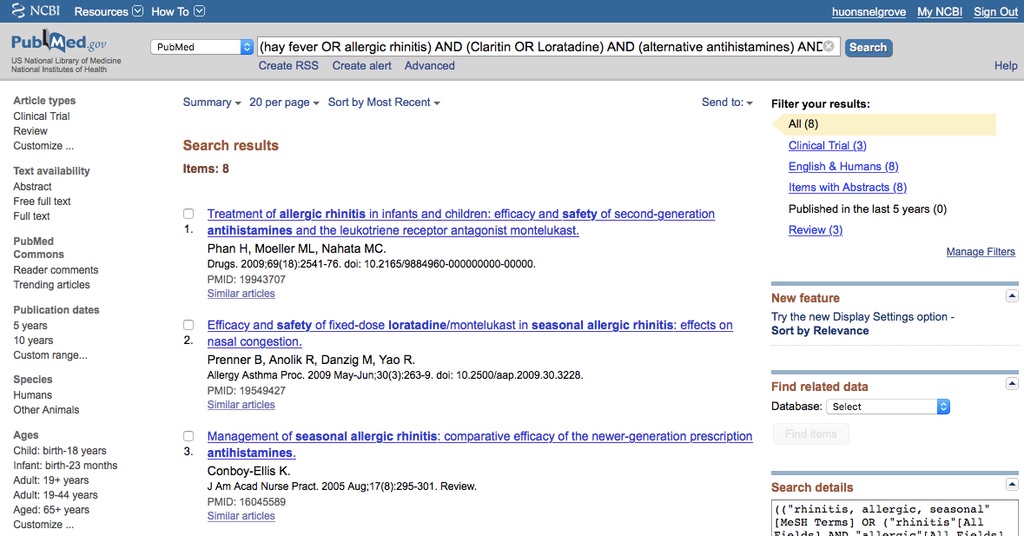Practice Search Exercises
Instructions
The following exercises will give you practice using PubMed. Exercise 1 is an example. Follow the steps and then try yourself. A pdf version of the online instructions and exercises is also available in the link)
To begin:
1. Register on PubMed and sign in as a user with 'My NCBI'
2. Do each of the search exercises below on your computer and save each search on 'My NCBI'
Exercise 1 - A worked example
Specific Question.
A mother and father come to your surgery with their 6-year-old son, John, who is
suffering from hay fever symptoms. The symptoms started 2 weeks ago. They have
tried antihistamines, but John fell asleep at school. John’s father asks:Are there medications that John can take that won’t make him sleepy? John’s mother
takes an anti histamine called Claritin (Loratadine) for her hay fever. Is that safe for
children?
STEP 1. What key words describe the problem?
| P | Allergy, allergic rhinitis, hay fever, hypersensitivity |
|---|---|
| I | Claritin OR Loratadine |
| C | Alternative antihistamines |
| O | Reduce symptoms, safety, efficacy, |
STEP 2. What is the clinical question?
In a 6 year old child is Claritin compared to alternative therapies more effective to reduce the symptoms of hay-fever?
STEP 3. What combinations of words will be most effective on Medline?
You need to experiment with different combinations and compare results
Combination 1:
(hay fever OR allergic rhinitis) AND (Claritin OR Loratadine) AND (alternative antihistamines) AND (safety OR reduction of symptoms)
Limits: Randomized Controlled Trial, Journal Article, English, All Child: 0-18 years, published in the last 5 years
Combination 2
Search 2: (hay fever) AND (Claritin OR Loratadine) AND (safety OR reduction of symptoms)
Limits: Randomized Controlled Trial, Journal Article, English, All Child: 0-18 years, published in the last 5 years

SEARCH STRATEGY STUDY COMMENTS
I used a few, but not all my combinations. After examining the abstracts I might decide to continue with more searches using other combinationsNotice that I used the Limits function to indicate ‘child’ and included MeSH and free text works.’
Because I was interested in studies whch asked ‘What treatment is best?’ I included a generic alternative in the comparison field (“alternative antihistamines’). However, this is not always necessary.
When I wrote “allergy” in the MeSH window I saw that “allergy” was not a MesH term. The MeSH browser indicated a synonym “ hypersensitivity”. With this word I scrolled down the MeSH page, or hierarchy of terms.
Under the term ‘hypersensitivity’ I found Hey fever/ Rhinitis, Allergy,Perennial. You can add these terms to you main search window.
Exercise 2 - You try
Specific Question.
A mother of a young African girl with cerebral malaria has told you she knows of a drug called ELQ-300 which may save her daughters life or at least reduce risks significantly.
Strategy
STEP 1: What key words describe the problem?
(Hint: Refer to your microbiology text for clinical information about cerebral malaria and use the MeSH function on PubMed to identify other key concepts)
You want to know if there is any evidence of a new drug that reduces risks of complications and/or death compared to current therapy.
‘Patient’ - What kind of patient? What is the condition?
Intervention’ - What do we want to do to help the patient?
Comparison - What alternatives of treatment exist?
Outcome’ - What do we want to happen after the intervention?
Create a table to generate your key words.
STEP 2: What is the clinical question?
STEP 3: Conduct your searches using different combinations of key words from your table
STEP 4: Share your KEY WORDS and successful search strategies on the Forum with other students

